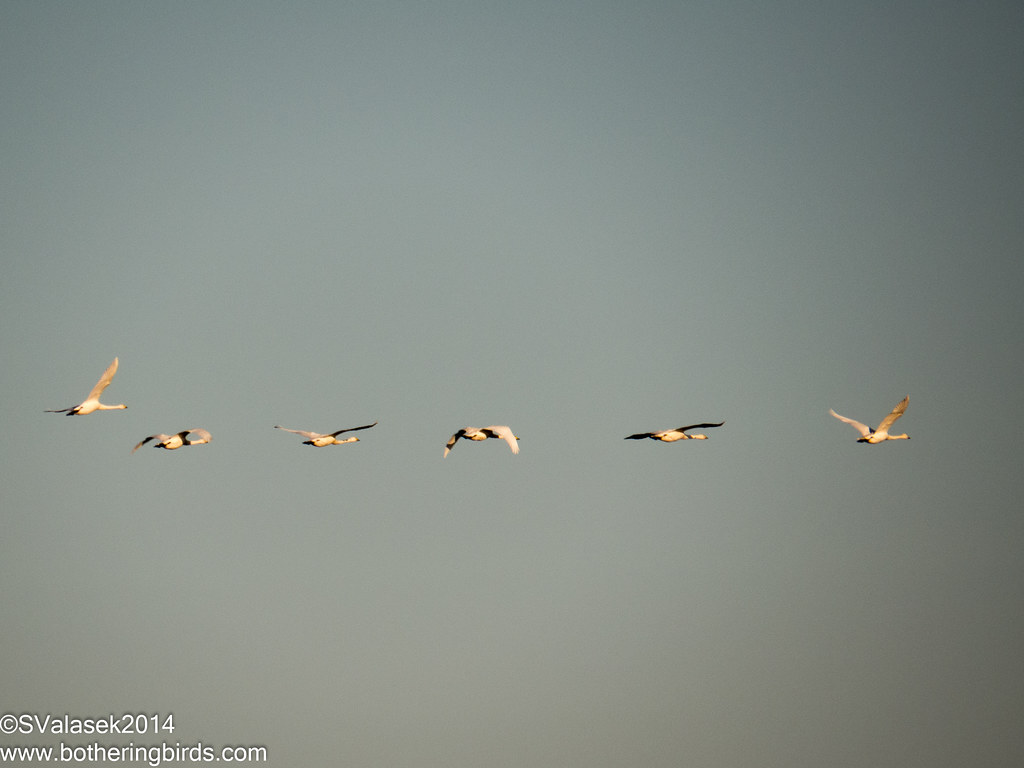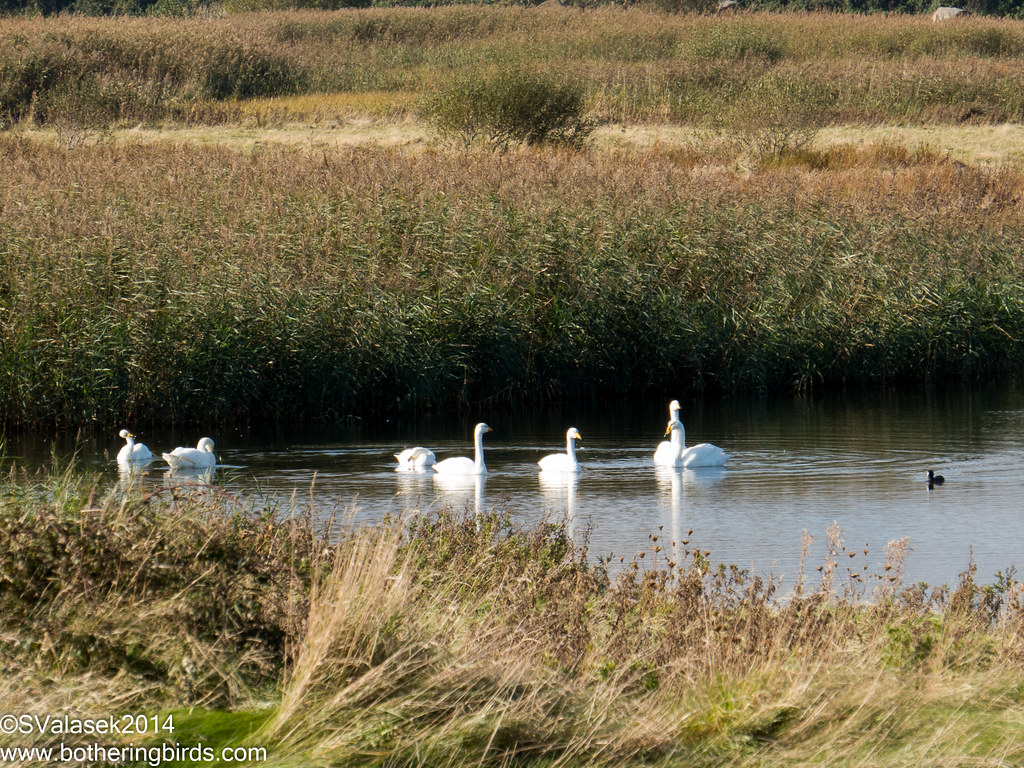On the walk to one of the fabulous hides that they have here in Ireland, we passed lots of songbirds, the usual Tits, Robins, Wrens, Bullfinches, Chaffinches and Stonechats. The usual winter visitors weren't there yet and only some Mallards were on the water in front of the hide. But we were soon treated to a flock of a dozen or so Common Sandpipers that made a few laps around the refuge. They never landed where we could see them, but we got some good looks as the passed in front of the hide. And then another bird flew in front of us and Brian said "Snipe!" A lone Common Snipe was spooked by something and circled a few times before flying off. This was a lifer for me. And was later joined by a second one, also flying off for some unseen reason.
There was a steady stream of gulls and corvids flying over during this time too, but a group of swans caught our eye and we ran out to follow them as they flew behind us towards the north.
 |
| Whooper Swans - ECNR Co. Wicklow, Ireland |
After a spell in the hide we decided to walk around and warm up a bit. We visited another hide without much going on, but saw a Jay flying over on our way out, which was another lifer for me. I learned that a white-patch on the rump is diagnostic for Jays in flight. We walked along some boardwalks and saw Stonechats everywhere.
 |
| Stonechat - ECNR Co. Wicklow, Ireland |
 |
| Kingfisher - ECNR Co. Wicklow, Ireland |
 |
| The view from our walk - Co. Wicklow, Ireland |
 |
| Whooper Swans and Coot - Co. Wicklow, Ireland |
 |
| Whooper Swans - Co. Wicklow, Ireland |
Our next stop was the small Irish village of Avoca. Apparently some TV show was filmed there ages ago, but not one that I was familiar with. But our target were Red Kites. Red Kites became extinct in Ireland in the 19th century, and almost in the UK too. But some work was done to let the species recover, and a scheme to reintroduce them to Ireland was started a few years ago with a number of Welsh Kites released in Co. Wicklow.
We parked near a stone bridge in the middle of town and walked out onto it. Brian said that we'd wait for a half hour and see if we could see some Kites. It wasn't more than 5 minutes when we spotted our first one. We were following a Raven when we spotted a Kite shape even further off cruising by off towards the coast. We waited a bit more and spotted another one in the opposite direction passing behind a tree line and doing some slow circles. Still too far to really see. And then behind where we were looking we saw one, and then two. One chased the other off and then circled our way. We both had our cameras firing away while it got closer and closer, finally passing about 30-meters directly over our heads, it was awesome.
We parked near a stone bridge in the middle of town and walked out onto it. Brian said that we'd wait for a half hour and see if we could see some Kites. It wasn't more than 5 minutes when we spotted our first one. We were following a Raven when we spotted a Kite shape even further off cruising by off towards the coast. We waited a bit more and spotted another one in the opposite direction passing behind a tree line and doing some slow circles. Still too far to really see. And then behind where we were looking we saw one, and then two. One chased the other off and then circled our way. We both had our cameras firing away while it got closer and closer, finally passing about 30-meters directly over our heads, it was awesome.
 |
| Red Kite - Avoca, Co. Wicklow, Ireland |
 |
| Red Kite - Avoca, Co. Wicklow, Ireland |
We wound up near the Powerscourt Waterfall at a stand of oak trees where he had seen Jays collecting acorns the previous day. We saw a few flying over the car before we got there, but only one in the oak trees. We waited and it finally flew into view before flying off to some pine trees where they were roosting.
 |
| Jay - Co. Wicklow, Ireland |
I'd like to thank Brian one more time and I'm looking forward to more trips. Maybe I'll even learn to understand the Dub accent.
I'm not sure if I'll get out again birding in the next week, but the family is going to Portugal in two weeks for mid-term break and a bit of Sun. But hopefully we get to see some wild Flamingos and Hoopoes too.
Cheers and thanks for making it this far.

An excellent write-up Steve, on my top birding spot in Co.Wicklow
ReplyDeleteCheck out this album for the Melanistic Pheasant
Also . . You've a little editing to do . . . I saw a Blue Flash not a green flash for our Kingfisher
and that would be some day seeing a Dunlin sitting along a fence which ran along the rail-line
Ha ha LOL, you must have been tired after the long walk when writing this up, they were Linnets with the 'Mippits'.
Again . . . a great days walk with good company, will have to do Rogerstown Estuary/Turvey Park with you some day soon.
With your E-Bird List below
Brian.
2014-10-12 08:38
East Coast NR
Protocol: Traveling
4.5 Miles
284 Minutes
Observers: 2
All birds reported? Yes
19 Mute Swan
7 Whooper Swan
26 Mallard
1 Ring-necked Pheasant blue type
3 Little Grebe
6 Great Cormorant
9 Gray Heron
17 Little Egret
1 Eurasian Coot
1 Eurasian Oystercatcher
2 Common Ringed Plover
12 Common Sandpiper large flock circling the hide at ECNR.
7 Common Redshank
1 Bar-tailed Godwit
2 Common Snipe flying around the hide at ECNR. we observed one fly off and a few moments later another fly by from opposite direction.
99 Black-headed Gull
4 Herring Gull
1 Lesser Black-backed Gull
1 Common Wood-Pigeon (White-necked)
2 Common Kingfisher
2 Eurasian Kestrel
1 Eurasian Jay
22 Eurasian Magpie
15 Eurasian Jackdaw
45 Rook
12 Hooded Crow
2 Barn Swallow (White-bellied)
3 Great Tit
5 Eurasian Blue Tit
12 Long-tailed Tit (europaeus)
11 Eurasian Wren
7 Goldcrest
12 European Robin
21 European Stonechat
6 Eurasian Blackbird
2 Dunnock
1 Gray Wagtail
3 White Wagtail pied
33 Meadow Pipit
2 Eurasian Bullfinch
2 European Greenfinch
150 European Goldfinch "multiple large flocks were seen all day flying in the same direction, north along the coast. "
40 Eurasian Linnet
2014-10-12 14:23
Kilmagig Lower, R754
Protocol: Stationary
38 Minutes
Observers: 2
All birds reported? Yes
3 Red Kite
1 Common Buzzard
7 Rook
5 Common Raven
2014-10-12 16:12
Glebe, R760
Protocol: Stationary
25 Minutes
Observers: 2
All birds reported? Yes
1 Gray Heron
5 Common Wood-Pigeon (White-necked)
1 Eurasian Jay
3 Eurasian Magpie
3 Eurasian Jackdaw
6 Rook
4 Hooded Crow
1 Great Tit
2 Mistle Thrush
2 Common Chaffinch (Common)
1 European Greenfinch
The TV show was Ballykissangle
ReplyDeletehttp://www.imdb.com/title/tt0115105/